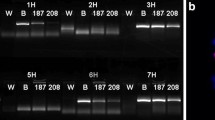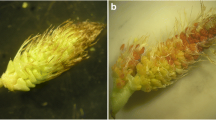Abstract
Cytological observations were made on embryo and endosperm tissues with different genome combinations that were produced by crossing the diploid and tetraploid cytotypes of Hordeum vulgare and H. bulbosum. The high frequency of barley haploids results from hybridization followed by the selective elimination of bulbosum chromosomes during the early development of embryos which initially contained a ratio of 1 vulgare to 1 bulbosum genomes. Elimination is gradual as indicated by the increase in the percentage of cells with the gametic chromosome number. However, the balance between genetic factors of the two parents appears to regulate the stability or elimination of chromosomes. Triploid embryos containing 1 vulgare to 2 bulbosum genomes are relatively stable. The most stable endosperm tissues examined had a ratio of 1 vulgare to 4 bulbosum genomes. Evidence of genetic control in both the vulgare and bulbosum chromosomes and their interaction is discussed. As has been suggested by Lange (1971) and also found in mammalian somatic cell hybrids, the most probable basis for selective chromosome elimination relates to mitotic rhythm and the duration of cell cycle phases.
Similar content being viewed by others
References
Barclay, I. R., Sheperd, K. W., Sparrow, D. H.: Chromosome elimination in Hordeum vulgare — Hordeum bulbosum hybrids. Biennial Report (1970–71) Waite Agric. Res. Inst., Univ. of Adelaide, S. Australia, 39–40 (1972).
Bennett, M. D., Smith, J. B.: The 4C nuclear DNA content of several Hordeum genotypes. Canad. J. Genet. Cytol. 13, 607–611 (1971).
Davies, D. R.: Male parthenogenesis in Barley. Heredity 12, 493–498 (1958).
Gupta, S. B.: Duration of mitotic cycle and Regulation of DNA replication in Nicotiana plumbaginifolia and a hybrid derivative of N. tabacum showing chromosome instability. Canad. J. Genet. Cytol. 11, 133–142 (1969).
Handmaker, S. D.: Cytogenetic analysis of Chinese hamster-mouse hybrid cell. Nature (Lond.) 233, 416–419 (1971).
Kao, K. N., Kasha, K. J.: Haploid from interspecific crosses with tetraploid barley. Barley Genetics 2, 82–87 (1969).
Kasha, K. J., Kao, K. N.: High frequency haploid production in barley (Hordeum vulgare L.). Nature (Lond.) 225, 874–876 (1970).
Kasha, K. J., Kao, K. N., Reinbergs, E.: Genetic control over chromosome stability in hybrids from interspecific Hordeum crosses. Genetics Suppl. 64, 33 (1970).
Kasha, K. J., Reinbergs, E., Johns, W. A., Subrahmanyam, N. C., Ho, K. M.: Barley Haploid Studies. Barley Genet. Newsl. 2, 36–41 (1972).
Kasha, K. J., Sadasivaiah, R. S.: Genome relationships between Hordeum vulgare L. and H. bulbosum L. Chromosoma (Berl.) 35, 264–287 (1971).
Lange, W.: Cytogenetical and embryological research on crosses between Hordeum vulgare and H. bulbosum. Versl. Landbouwk. Onderz. 719: pp 162, 1969.
Lange, W.: Crosses between Hordeum vulgare L. and H. bulbosum L. I. Production, morphology and meiosis of hybrids, haploids and dihaploids. Euphytica (Wageningen) 20, 14–29 (1971a).
Lange, W.: Crosses between Hordeum vulgare L. and H. bulbosum L. II. Elimination of chromosomes in hybrid tissues. Euphytica (Wageningen) 20, 181–194 (1971b).
Plaut, W., Nash, D., Fanning, T.: Ordered replication of DNA in polytene chromosomes of Drosophila melanogaster. J. molec. Biol. 16, 85–93 (1966).
Rajhathy, T.: Notes on some interspecific Hordeum hybrids. 1966 Barley Newsl. 10, 69–70 (1967).
Rao, P. N., Johnson, R. T.: Premature chromosome condensation: A mechanism for the elimination of chromosomes in virus-fused cells. J. Cell Sci. 10, 495–513 (1972).
Rhoades, M. M., Dempsey, E.: On the mechanism of chromatin loss induced by the B chromosome of maize. Genetics 71, 73–96 (1972).
Rhoades, M. M., Dempsey, E., Ghidoni, A.: Chromosome elimination in maize induced by supernumerary B chromosomes. Proe. nat. Acad. Sci. (Wash.) 57, 1626–1632 (1967).
Sadasivaiah, R. S., Kasha, K. J.: Meiosis in haploid barley — An interpretation of non-homologous chromosome associations. Chromosoma (Berl.) 35, 247–263 (1971).
Schooler, A. B.: Interspecific hybrids of Hordeum. 1962 Barley Newsletter 6, 47–48 (1963).
Symko, S.: Haploid barley from crosses of Hordeum bulbosum (2x) × Hordeum vulgare (2x). Canad. J. Genet. Cytol. 11, 602–608 (1969).
Weiss, M. C., Ephrussi, B.: Studies of interspecific (rat × mouse) somatic hybrids. I. Isolation, growth and evolution of the karyotype. Genetics 54, 1095–1109 (1966).
Weiss, M. C., Green, H.: Human-mouse hybrid cell lines containing partial complements of human chromosomes and functioning human genes. Proc. nat. Acad. Sci. (Wash.) 58, 1104–1111 (1967).
Westerveld, A., Visser, R. P. L. S., Khan, P. M., Bootsma, D.: Loss of human genetic markers in man-Chinese hamster somatic cell hybrids. Nature (Lond.) New Biol. 234, 20–24 (1971).
Author information
Authors and Affiliations
Rights and permissions
About this article
Cite this article
Subrahmanyam, N.C., Kasha, K.J. Selective chromosomal elimination during haploid formation in barley following interspecific hybridization. Chromosoma 42, 111–125 (1973). https://doi.org/10.1007/BF00320934
Received:
Issue Date:
DOI: https://doi.org/10.1007/BF00320934




